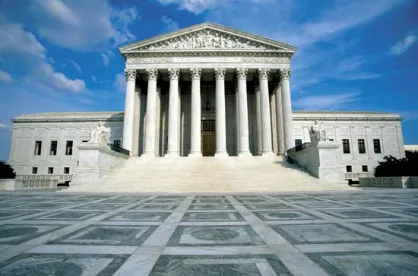On January 13, 2015, the United States Supreme Court heard oral arguments in Mach Mining, LLC v. EEOC, 738 F.3d 171 (7th Cir. 2013), a case that squarely addresses the duties of the EEOC during the conciliation process. On one hand, Title VII lays out a conciliation process that, arguably, aims to remedy acts of discrimination through a discretionary, informal proceeding. On the other hand, the American legal system, in its perpetual pursuit of justice and fairness, does not often take government agencies' word that these interests were served. So, here we are.
The EEOC argued the conciliation process is not within the courts' scope of judicial review, while Mach Mining argued courts must make some rudimentary determinations to ensure the EEOC acts in good faith and fosters a fair conciliation process.
Without question, Mach Mining has engaged in a pattern of gender discrimination with regard to jobs at its mining facilities. No woman has ever been employed as a mine worker. In fact, Mach Mining recently built new facilities for mine workers, and these facilities do not include a bathroom or changing room for women. In short, the merits of a discrimination claim against Mach Mining are compelling. The legal issue presented, however, is infinitely more far-reaching than this single discrimination claim.
Subsequent to the EEOC's investigation which resulted in a finding of reasonable cause to believe Mach Mining had discriminated against a class of female job applicants at its mine near Johnston City, Illinois, the EEOC notified Mach Mining of its intention to begin informal conciliation in late 2010. Although it is unclear what events, if any, occurred during the conciliation process, the EEOC notified Mach Mining in September 2011 that the agency had deemed negotiations to be unsuccessful and filed its complaint in federal court two weeks later. Thereafter, Mach Mining filed a motion to dismiss the EEOC's claim, alleging that the EEOC failed to adequately participate in the mandatory conciliation process (as an affirmative defense).
In response, the EEOC moved for summary judgment, claiming the conciliation process is not subject to judicial review and also moved to strike Mach Mining's affirmative defense. The district court denied both of the EEOC's motions. On appeal, the Seventh Circuit reversed the district court by holding the conciliation process is not, in fact, subject to judicial review. The Seventh Circuit's decision exacerbated a pre-existing split among eight other federal Appellate Courts. The Supreme Court granted certiorari in order to address the debated issue of whether the EEOC's actions during conciliation are subject to judicial review.
Although this case seems to present a yes-or-no question, the legal and practical considerations in making the determination open a Pandora's Box of complicated and unpredictable outcomes. Mach Mining is arguing for a standard that would require the EEOC to engage the employer by initiating the conciliation and making an offer within the scope of what the EEOC could reasonably expect to obtain at trial. Mach Mining argues that the problem with conciliation is that the EEOC, if it makes an offer or demand, often demands drastically more in conciliation than the case would ever be worth on the merits. For example, the EEOC might demand $5 million during conciliation in a case worth, at most, $1 million based on the merits and historical jury verdicts. In contrast, the EEOC's position is that courts have no authority to review the EEOC's actions during the conciliation process. According to the EEOC, once the agency provides documentation that a conciliation process was initiated and was unsuccessful, the Title VII requirement is satisfied.
Believe it or not, the EEOC's argument is substantially supported by its interpretation of Title VII and federal case law relating to private rights of action and the Administrative Procedure Act (APA). Congress, in drafting Title VII, did not intend to create a private right of action for employers by including the conciliation requirement although most lawyers would agree conciliation was meant to be an efficient alternative measure of satisfying discrimination claims. In addition, the APA allows for judicial review only when a government agency exercises its delegated powers to promulgate a rule or adjudicate a claim. The EEOC is an advocate for employees and does not have the power to adjudicate discrimination claims. Thus, there is really no clear-cut legal basis on which to establish courts' judicial review of EEOC actions prior to its filing of a discrimination claim. This is why the EEOC has steadfastly argued judicial review is not appropriate.
Although the EEOC's argument has legal support, the current state of the relationship between employers and the EEOC causes many lawyers, including most of the Supreme Court Justices, to be skeptical. This response is prompted by two fundamental flaws in the procedure by which the EEOC has elected to carry out its noble and, indeed, necessary mission of deterring employment discrimination. The Court briefly discussed both flaws during oral argument. First, the EEOC's budgetary limitations incentivize the agency to litigate discrimination cases that will attain more publicity and, perhaps, have a greater effect on employers. This strategy is problematic because it places the burden on few employers to remedy the wrongs of many employers. In other words, the EEOC is compensating for its budget restrictions by pursuing claims brought against certain employers who are able to fund lengthy, contested litigation. Second, and perhaps more importantly, the employee or employees for whom the EEOC is advocating have no real representation in their claim. In essence, the EEOC's "clients" are simply pawns in the EEOC's mission to end employment discrimination. For example, if an employer responds to the EEOC's $1 million demand with a $500,000 offer during conciliation, the employee or employees who initiated the claim may very well be satisfied with the offer, but the EEOC is not necessarily bound by the preference of the claimants. As a result, the EEOC's litigation may penalize employers rather than aiming to obtain a remedy for a wronged employee.
Mach Mining's argument and sought remedies are no less problematic. Clearly, Mach Mining's aim is to create a less leveraged bargaining situation during the conciliation process. Within the framework of Title VII and case law precedent, however, the EEOC cannot be stripped of its leverage without overhauling the system. The Supreme Court cannot feasibly do without the support of Congress or the Executive.
Mach Mining is arguing for a conciliation process in which the EEOC is obligated to put forth a "reasonable" offer, or one that the merits of the case might justify after litigation. One problem with this standard, however, is that courts would then have to assess the reasonableness of the EEOC's bargaining during the conciliation process. This would require extensive litigation without addressing the merits of the case. Another problem is Title VII's requirement that all actions and negotiations during conciliation may not be used as evidence during litigation. As Mach Mining's counsel noted during oral argument, employers are free to publish the EEOC's actions and conciliation offers in the New York Times, but Title VII does not allow employers to use the same actions as evidence against the EEOC during litigation. How, then, could a court possibly determine whether the EEOC's conciliation efforts were reasonable, and what expertise would a court have to determine the validity of EEOC-employer bargaining?
Several federal Circuit Courts of Appeal have attempted to construct standards by which to assess whether a conciliation was reasonable, but these standards are conjured out of thin air and lack the teeth of statutory or case law support. See EEOC v. Mach Mining, LLC, No. 11-cv-879-JPG-PMF, 2013 U.S. Dist. LEXIS 71172, at *5-9 (S.D. Ill. May 20, 2013) (summarizing rulings on the EEOC's conciliation process in different federal jurisdictions). In sum, Mach Mining's proposed standards may seem more just, but they would be a difficult to apply and are unsupported by Title VII or any case law precedent.
At oral argument, the Court recognized the problems with the arguments on both sides and seemed uncertain on how to set forth a fair standard for future conciliations. On one hand, the Court stated it would not simply "take the government's word" that its conciliation actions are adequate. Such a stance would effectively strip the Court of its reviewing power if applied to all government agencies. On the other hand, the Court does not want to effectively shun Title VII and create a legal labyrinth by empowering courts to review the discretionary actions of the EEOC. As a compromise, Justice Breyer suggested the possibility of granting courts the discretion to request more information from the EEOC, with regard to its conciliation efforts, if bad faith is suspected. Unsurprisingly, this compromise did not seem acceptable to either party—the EEOC maintained that any judicial review is unwarranted, and Mach Mining argued Justice Breyer's compromise is insufficient to effectively require the EEOC to conciliate in good faith.
Only briefly mentioned during oral argument was the point that may be the driving force behind the Court's forthcoming opinion. The EEOC has the power to promulgate rules regarding the conciliation process. To date, however, the EEOC has not promulgated any such rules due to their need for "flexibility" in conciliating discrimination claims. The Court seemed interested in the prospect of issuing an opinion that would require the EEOC to issue, and follow, its own rules regarding the conciliation process. These rules would be judicially reviewable, and the existence of such rules would create more transparency for both courts and employers to evaluate the actions of the EEOC.
As of today, no changes have been made to the conciliation process, and employers need not take any immediate action in preparation for the Supreme Court's opinion in this case. However, all employers should be aware that the opinion is forthcoming and consult an attorney once the case is decided. The Court's opinion has the potential to drastically change the conciliation process and the relationship between employers and the EEOC.




 />i
/>i
